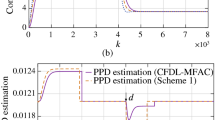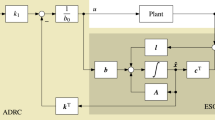Abstract
This note presents dual peak control to attenuate influence of external disturbances introduced from plant input and output. The proposed controller elevates tracking performance by simultaneously suppressing peaks of torque disturbance and error sensitivity functions. Unlike conventional methods, the proposed weighting functions are scalar, which results in a minimal order controller. In addition, the closed loop systems designed by the proposed method are always stable because the proposed control is originated from Lyapunov stability. Experimental verifications demonstrate the effectiveness of the suggested design method and it is confirmed that the controller suppresses two peaks and enhances tracking performance obviously.










Similar content being viewed by others
References
Boyd S, Ghaoui LE, Feron E, Balakrishnan V (1994) Linear matrix inequalities in system and control theory. SIAM, Philadelphia
de Oliveira MC, Geromel JC, Bernussou J (1999) An LMI optimization approach to multiobjective controller design for discrete-time systems. In: Proceedings of the 38th Conference on Decision and Control, vol 4, issue 7–10, pp 3611–3616
Franklin GF, Powell JD, Workman ML (1990) Digital control of dynamic systems. Addison-Wesley Publishing Company, Reading
Kempf CJ, Kobayashi S (1996) Discrete-time disturbance observer design for systems with time delay. em AMC 1:332–337
Ohnishi K (1987) A new servo method in mechatronics. Trans Jpn Soc Electr Eng 107-D:83–86
Sacks AH, Bodson M, Messner W (1995) Advanced methods for repeatable runout compensation. IEEE Trans Magnet 31(2):1031–1036
Semba T (2003) A disturbance observer to suppress vibration effects of a HDD in a disk array system. In: Proceeding of the American Control Conference, pp 1362–1367
Skogestad S, Postlethwaite I (1996) Multivariable feedback control: analysis and design. Wiley, Chicheste
Suh S (2009) Discrete-time controller design to attenuate effects of external disturbances. Microsyst Technol 15(10–11):1645–1651
Suh S (2010) Unified H ∞ control to suppress vertices of plant input and output sensitivity functions. IEEE Trans Control Syst Technol 18(4):969–975
Tomizuka M (1987) Zero phase error tracking algorithm for digital control. J Dynamic Syst Measur Control 109:65–68
Vidyasagar M (1985) Control system synthesis: a factorization approach. The MIT Press, Boston
White MT, Tomizuka M (2000) Improved track following in magnetic disk drives using a disturbance observer. IEEE/ASME Trans Mechatron 5(1):3–11
Yi L, Tomizuka M (1999) Two-degree-of-freedom control with robust feedback control for hard disk servo systems. IEEE/ASME Trans Mechatron 4(1):17–24
Author information
Authors and Affiliations
Corresponding author
Rights and permissions
About this article
Cite this article
Park, KS., Suh, S. Discrete-time dual peak control for disturbance rejection. Microsyst Technol 18, 1645–1650 (2012). https://doi.org/10.1007/s00542-012-1602-1
Received:
Accepted:
Published:
Issue Date:
DOI: https://doi.org/10.1007/s00542-012-1602-1




